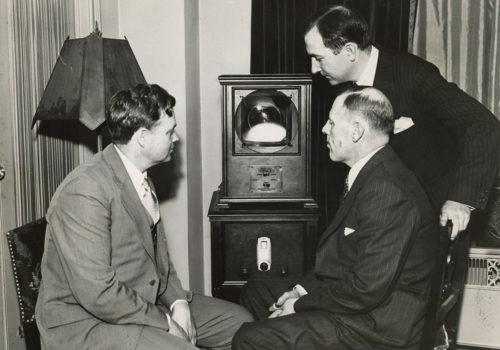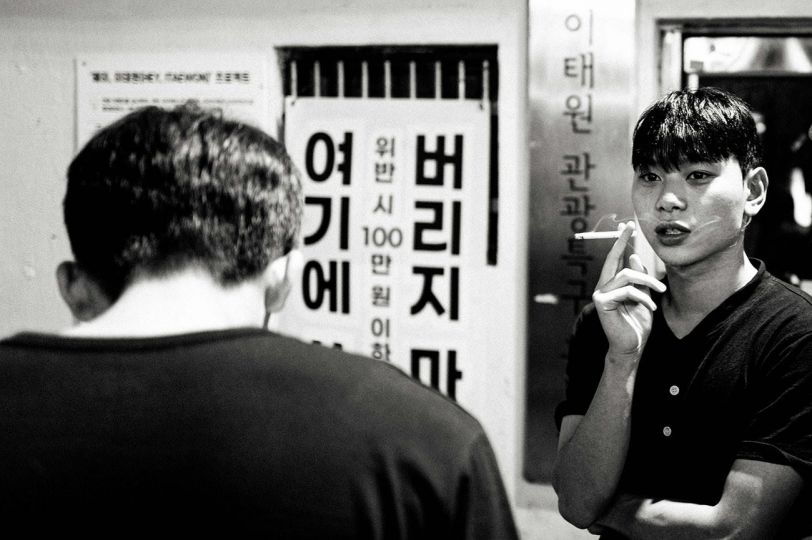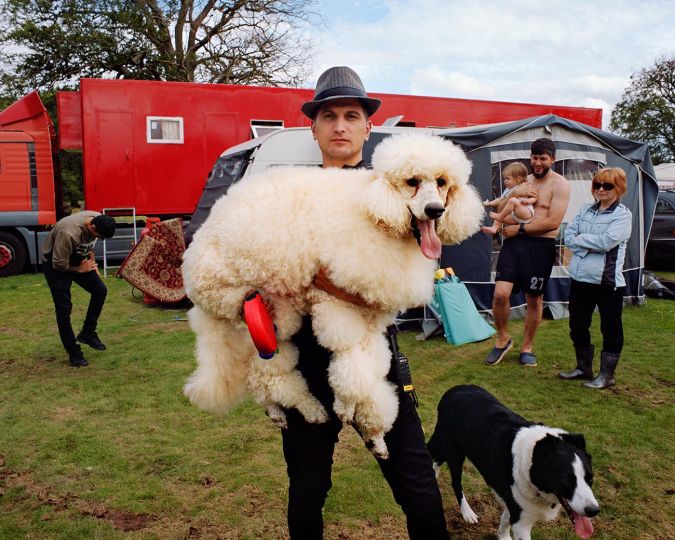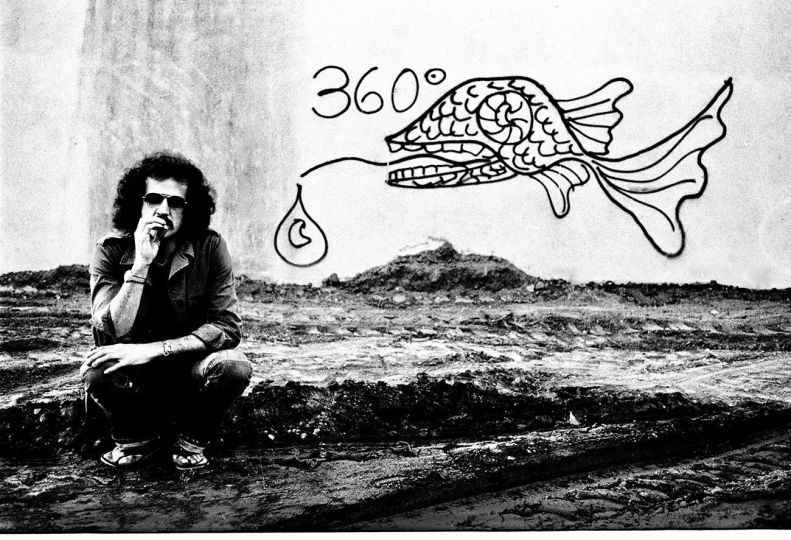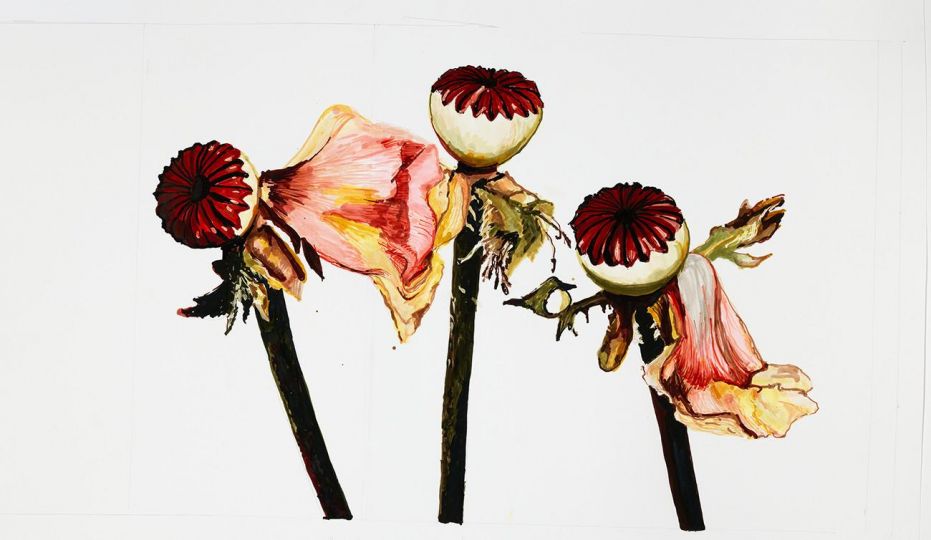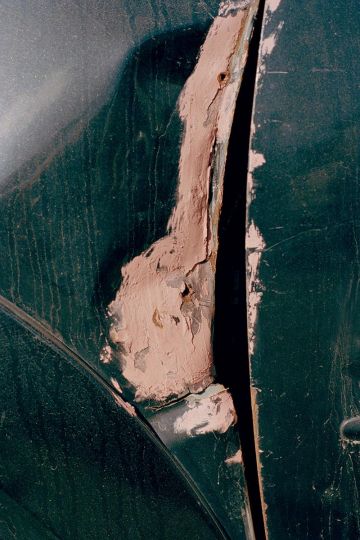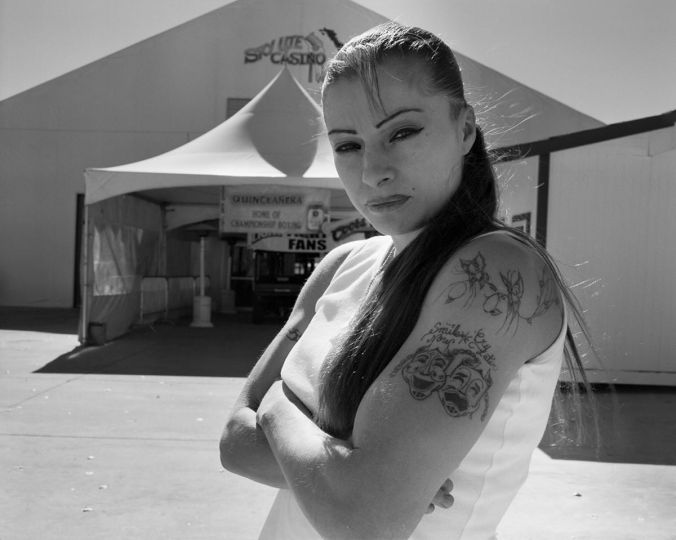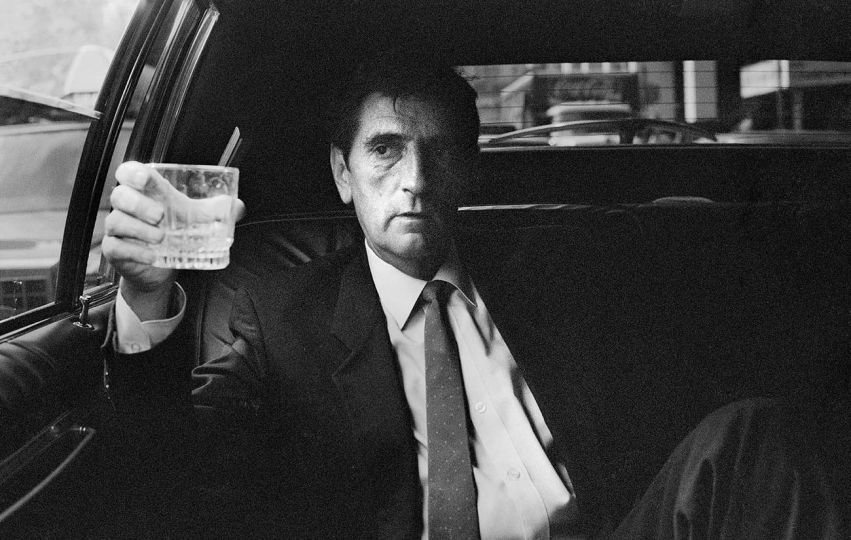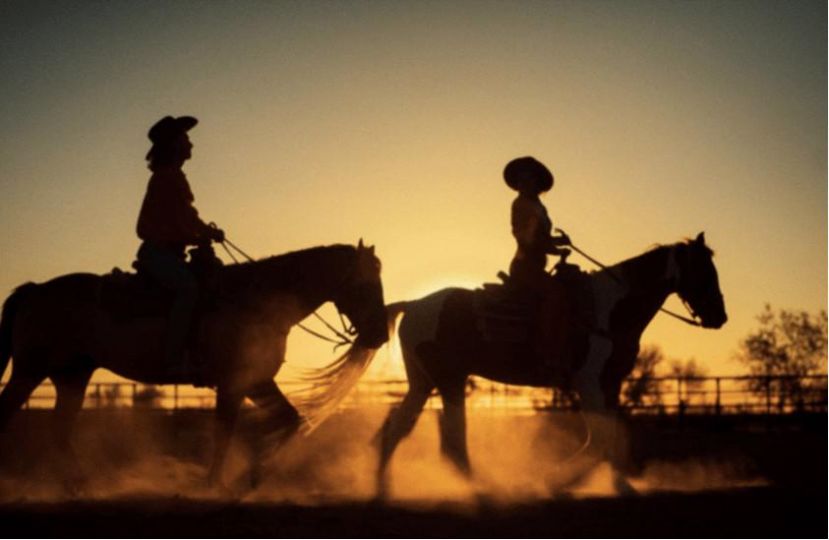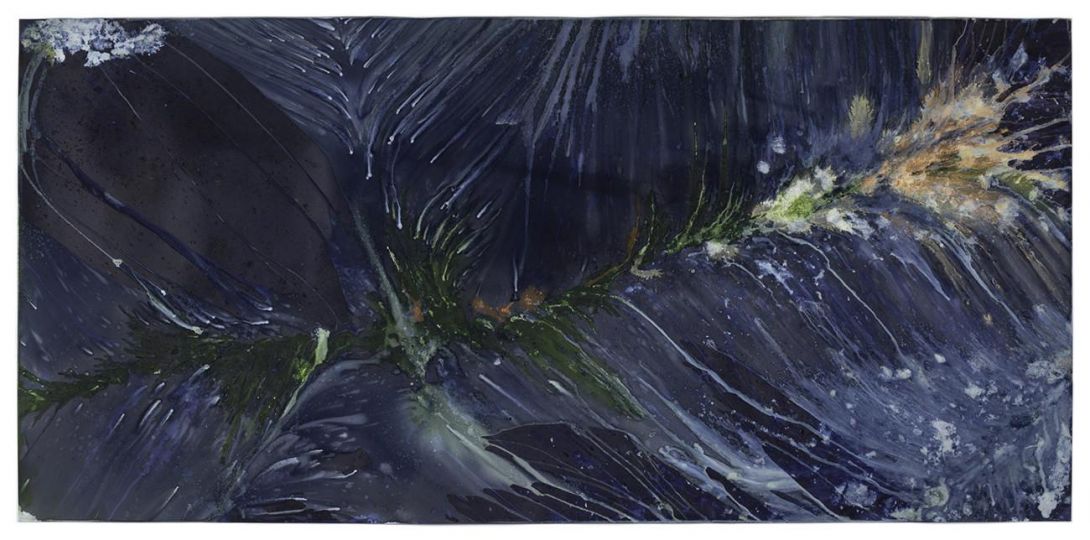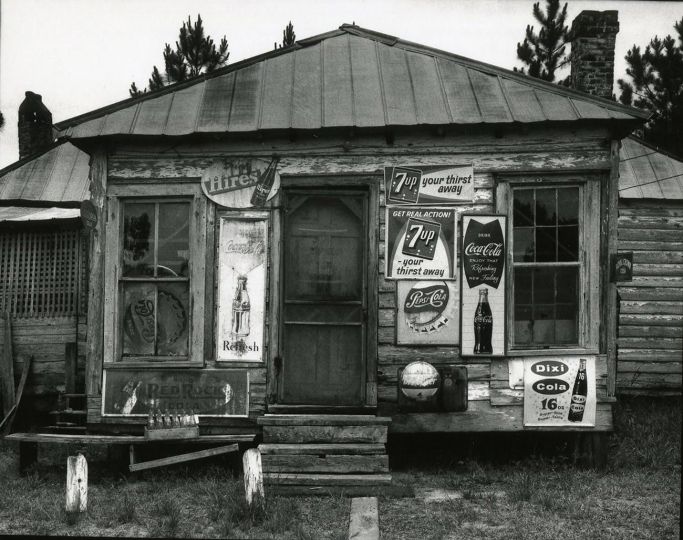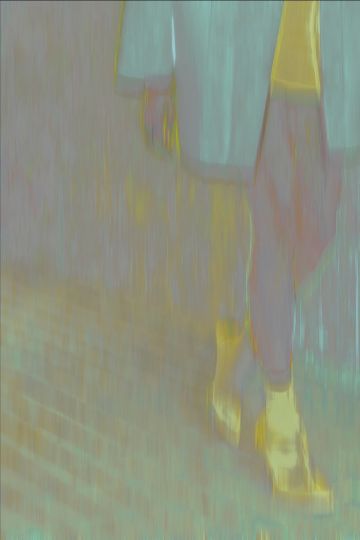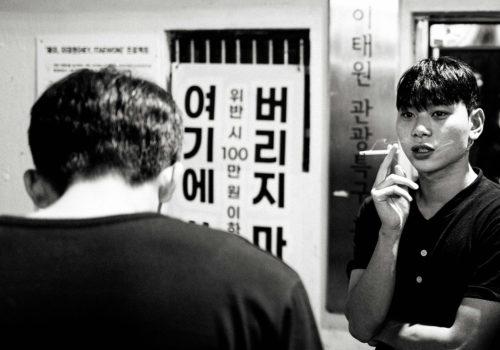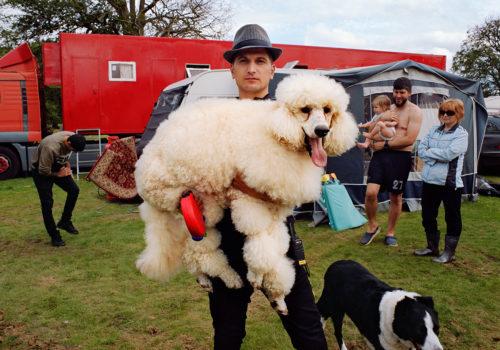Keith de Lellis Gallery presents the exhibition Cool Medium : The Golden Age of Television. Mitchell Stephens writes :
HISTORY OF TELEVISION
Few inventions have had as much effect on contemporary American society as television. Before 1947 the number of U.S. homes with television sets could be measured in the thousands. By the late 1990s, 98 percent of U.S. homes had at least one television set, and those sets were on for an average of more than seven hours a day. The typical American spends (depending on the survey and the time of year) from two-and-a-half to almost five hours a day watching television. It is significant not only that this time is being spent with television but that it is not being spent engaging in other activities, such as reading or going out or socializing.
EXPERIMENTS
Electronic television was first successfully demonstrated in San Francisco on Sept. 7, 1927. The system was designed by Philo Taylor Farnsworth, a 21-year-old inventor who had lived in a house without electricity until he was 14. While still in high school, Farnsworth had begun to conceive of a system that could capture moving images in a form that could be coded onto radio waves and then transformed back into a picture on a screen. Boris Rosing in Russia had conducted some crude experiments in transmitting images 16 years before Farnsworth’s first success. Also, a mechanical television system, which scanned images using a rotating disk with holes arranged in a spiral pattern, had been demonstrated by John Logie Baird in England and Charles Francis Jenkins in the United States earlier in the 1920s. However, Farnsworth’s invention, which scanned images with a beam of electrons, is the direct ancestor of modern television. The first image he transmitted on it was a simple line. Soon he aimed his primitive camera at a dollar sign because an investor had asked, “When are we going to see some dollars in this thing, Farnsworth?”
EARLY DEVELOPMENT
RCA, the company that dominated the radio business in the United States with its two NBC networks, invested $50 million in the development of electronic television. To direct the effort, the company’s president, David Sarnoff, hired the Russian-born scientist Vladimir Kosma Zworykin, who had participated in Rosing’s experiments. In 1939, RCA televised the opening of the New York World’s Fair, including a speech by President Franklin Delano Roosevelt, who was the first president to appear on television. Later that year RCA paid for a license to use Farnsworth’s television patents. RCA began selling television sets with 5 by 12 in (12.7 by
25.4 cm) picture tubes. The company also began broadcasting regular programs, including scenes captured by a mobile unit and, on May 17, 1939, the first televised baseball game between Princeton and Columbia universities. By 1941 the Columbia Broadcasting System (CBS), RCA’s main competition in radio, was broadcasting two 15-minute newscasts a day to a tiny audience on its New York television station.
Early television was quite primitive. All the action at that first televised baseball game had to be captured by a single camera, and the limitations of early cameras forced actors in dramas to work under impossibly hot lights, wearing black lipstick and green makeup (the cameras had trouble with the color white). The early newscasts on CBS were “chalk talks,” with a newsman moving a pointer across a map of Europe, then consumed by war. The poor quality of the picture made it difficult to make out the newsman, let alone the map. World War II slowed the development of television, as companies like RCA turned their attention to military production. Television’s progress was further slowed by a struggle over wavelength allocations with the new FM radio and a battle over government regulation. The Federal Communications Commission’s (FCC) 1941 ruling that the National Broadcasting Company (NBC) had to sell one of its two radio networks was upheld by the Supreme Court in 1943. The second network became the new American Broadcasting Company (ABC), which would enter television early in the next decade. Six experimental television stations remained on the air during the war one each in Chicago, Philadelphia, Los Angeles, and Schenectady, N.Y., and two in New York City. But full-scale commercial television broadcasting did not begin in the United States until 1947.
THE BEGINNING OF COMMERCIAL TELEVISION
By 1949 Americans who lived within range of the growing number of television stations in the country could watch, for example, The Texaco Star Theater (1948), starring Milton Berle, or the children’s program, Howdy Doody (1947-60). They could also choose between two 15-minute newscasts CBS TV News (1948) with Douglas Edwards and NBC’s Camel News Caravan (1948) with John Cameron Swayze (who was required by the tobacco company sponsor to have a burning cigarette always visible when he was on camera). Many early programs such as Amos ‘n’ Andy (1951) or The Jack Benny Show (1950-65) were borrowed from early television’s older, more established Big Brother: network radio. Most of the formats of the new programs newscasts, situation comedies, variety shows, and dramas were borrowed from radio, too (see radio broadcasting and television programming). NBC and CBS took the funds needed to establish this new medium from their radio profits. However, television networks soon would be making substantial profits of their own, and network radio would all but disappear, except as a carrier of hourly newscasts. Ideas on what to do with the element television added to radio, the visuals, sometimes seemed in short supply. On news programs, in particular, the temptation was to fill the screen with “talking heads,” newscasters simply reading the news, as they might have for radio. For shots of news events, the networks relied initially on the newsreel companies, whose work had been shown previously in movie studios. The number of television sets in use rose from 6,000 in 1946 to some 12 million by 1951. No new invention entered American homes faster than black and white television sets; by 1955 half of all U.S. homes had one.
McCARTHYISM
In 1947 the House Committee on Un-American Activities began an investigation of the film industry, and Sen. Joseph R. McCarthy soon began to inveigh against what he claimed was Communist infiltration of the government. Broadcasting, too, felt the impact of this growing national witch-hunt. Three former members of the Federal Bureau of Investigation (FBI) published “Counterattack: The Newsletter of Facts on Communism,” and in 1950 a pamphlet, “Red Channels,” listed the supposedly Communist associations of 151 performing artists. Anti-Communist vigilantes applied pressure to advertisers he source of network profits. Political beliefs suddenly became grounds for getting fired. Most of the producers, writers, and actors who were accused of having had left-wing leanings found themselves blacklisted, unable to get work. CBS even instituted a loyalty oath for its employees. Among the few individuals in television well positioned enough and brave enough to take a stand against McCarthyism was the distinguished former radio reporter Edward R. Murrow. In partnership with the news producer Fred Friendly, Murrow began See It Now, a television documentary series, in 1950. On Mar. 9, 1954, Murrow narrated a report on McCarthy, exposing the senator’s shoddy tactics. Of McCarthy, Murrow observed, “His mistake has been to confuse dissent with disloyalty.” A nervous CBS refused to promote Murrow and Friendly’s program. Offered free time by CBS, McCarthy replied on April 6, calling Murrow “the leader and the cleverest of the jackal pack which is always found at the throat of anyone who dares to expose Communist traitors.” In this TV appearance, McCarthy proved to be his own worst enemy, and it became apparent that Murrow had helped to break McCarthy’s reign of fear. In 1954 the U.S. Senate censured McCarthy, and CBS’s “security” office was closed down.
THE GOLDEN AGE
Between 1953 and 1955, television programming began to take some steps away from radio formats. NBC television president Sylvester Weaver devised the “spectacular,” a notable example of which was Peter Pan (1955), starring Mary Martin, which attracted 60 million viewers. Weaver also developed the magazine-format programs Today, which made its debut in 1952 with Dave Garroway as host (until 1961), and The Tonight Show, which began in 1953 hosted by Steve Allen (until 1957). The third network, ABC, turned its first profit with youth-oriented shows such as Disneyland, which debuted in 1954 (and has since been broadcast under different names), and The Mickey Mouse Club (1955-59; see Disney, Walt).
The programming that dominated the two major networks in the mid-1950s borrowed heavily from another medium: theater. NBC and CBS presented such noteworthy, and critically acclaimed, dramatic anthologies as Kraft Television Theater (1947), Studio One (1948), Playhouse 90 (1956), and The U.S. Steel Hour (1953). Memorable television dramas of the era most of them broadcast live included Paddy Chayefsky’s Marty (1955), starring Rod Steiger (Ernest Borgnine starred in the film), and Reginald Rose’s Twelve Angry Men (1954). By the 1955-56 television season, 14 of these live-drama anthology series were being broadcast. This is often looked back on as the “Golden Age” of television. However, by 1960 only one of these series was still on the air. Viewers apparently preferred dramas or comedies that, while perhaps less literary, at least had the virtue of sustaining a familiar set of characters week after week. I Love Lucy, the hugely successful situation comedy starring Lucille Ball and Desi Arnaz, had been recorded on film since it debuted in 1951 (lasting until 1957). It had many imitators. The Honeymooners, starring Jackie Gleason, was first broadcast, also via film, in 1955 (lasting until 1956 with the original cast). The first videotape recorder was invented by Ampex in 1956 (see video; video recording; video technology). Another format introduced in the mid-1950s was the big-money quiz show. The $64,000 Question (1955-58) and Twenty-One (1956-58) quickly shot to the top of the ratings. In 1959, however, the creator of The $64,000 Question, Louis C. Cowan, by that time president of CBS television, was forced to resign from the network amid revelations of widespread fixing of game shows (see Van Doren, Charles).
TELEVISION AND POLITICS
Television news first covered the presidential nominating conventions of the two major parties, events then still at the heart of America politics, in 1952. The term “anchorman” was used, probably for the first time, to describe Walter Cronkite’s central role in CBS’s convention coverage that year. In succeeding decades these conventions would become so concerned with looking good on television that they would lose their spontaneity and eventually their news value. The power of television news increased with the arrival of the popular newscast, The Huntley-Brinkley Report, on NBC in 1956 (see Huntley, Chet, and Brinkley, David). The networks had begun producing their own news film. Increasingly, they began to compete with newspapers as the country’s primary source of news (see journalism).
The election of a young and vital president in 1960, John F. Kennedy, seemed to provide evidence of how profoundly television would change politics. Commentators pointed to the first televised debate that fall between Kennedy, the Democratic candidate for president, and Vice-President Richard M. Nixon, the Republican’s nominee. A survey of those who listened to the debate on radio indicated that Nixon had won; however, those who watched on television, and were able to contrast Nixon’s poor posture and poorly shaven face with Kennedy’s poise and grace, were more likely to think Kennedy had won the debate. Television’s coverage of the assassination of President Kennedy on Nov. 22, 1963, and of the events that followed, provided further evidence of the medium’s power. Most Americans joined in watching coverage of the shocking and tragic events, not as crowds in the streets, but from their own living rooms. A newscast that would soon surpass the popularity of Huntley-Brinkley, The CBS Evening News with Walter Cronkite, debuted in 1962 (and was broadcast until 1981). By the end of the decade Cronkite had become not just a highly respected journalist but, according to public opinion surveys, “the most trusted man in America.” His role in coverage of the Vietnam War would be important. While the overwhelming majority of television news reports on the Vietnam War were supportive of U.S. policy, television news film of the fighting sometimes gave Americans back home an unfamiliar, harsh, and unromantic view of combat. Many believed it contributed to growing public dissatisfaction with the war. And some of the anger of those defending U.S. policy in Vietnam was leveled against television news. In 1965, CBS reporter Morley Safer accompanied a group of U.S. Marines on a “search and destroy” mission to a complex of hamlets called Cam Ne. The Marines faced no enemy resistance, yet they held cigarette lighters to the thatched roofs and proceeded to “waste” Cam Ne. After much debate, Safer’s filmed report on the incident was shown on CBS. Early the next morning the president of CBS received an angry phone call from the president of the United States, Lyndon B. Johnson, accusing the network of a lack of patriotism. During the Tet offensive in 1968, Cronkite went to Vietnam to report a documentary on the state of the war. That documentary, broadcast on Feb. 28, 1968, concluded with what Cronkite has described as “a clearly labeled editorial”: “It is increasingly clear to this reporter that the only rational way out will be to negotiate,” he said. President Johnson was watching Cronkite’s report. According to Bill Moyers, one of his press aides at the time: “The president flipped off the set and said, `If I’ve lost Cronkite, I’ve lost middle America.’”
Mitchell Stephens
Cool Medium :The Golden Age of Television
December 5, 2024 – January 31, 2025
Keith de Lellis Gallery
41 E 57th Street , Suite 703
New York, N Y 10022
www.keithdelellisgallery.com

